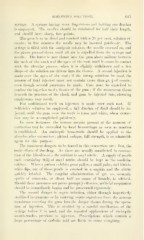Page 645 - My FlipBook
P. 645
;
SCHLEICH'S SOLUTIONS. 643
svriiige. A syringe having stout finger-rests and holding one drachni
is employed. The needles should be reinforced for half their length,
and should have sharp, fine points.
The gum is to be dried and touched with a 20 per cent, solution of
cocain ; in five minutes the needle may be inserted painlessly. The
syringe is filled with the analgesic solution, the needle screwed on, and
the piston pressed down until all air is expelled from the syringe and
needle. The latter is now thrust into the gum about midway between
the neck of the tooth and the apex of the root, until it comes in contact
with the alveolar process, when it is slightly withdrawn and a few
drops of the solution are driven into the tissues. A second injection is
made over the apex of the root ; if the strong solutions be used, the
amount of fluid injected must not contain more than gr. ^ of cocain
even though several punctures be made. Care must be exercised to
confine the injection to the tissues of the gum ; if the submucous tissue
beneath the junction of the cheek and gum be injected into, alarming
emphysema may result.
For multirooted teeth an injection is made over each root. If
Schleich's solution be employed, a full drachm of fluid should be in-
jected, until the gum over the tooth is tense and white, when extrac-
tion may be accomplished painlessly.
In some instances the intense anemia present at the moment of
extraction may be succeeded by local hemorrhage as soon as reaction
is established. An antiseptic hemostatic should be applied to the
alveolus after extraction ; phenol sodique, full strength, is an admirable
agent for this purpose.
The imminent dangers to be feared in this connection are : first, the
toxic effects of the drug. As these are usually manifested in contrac-
tion of the bloodvessels the antidote is amyl nitrite. A supply of pearls
each containing TTliij of amyl nitrite should be kept in the medicine
cabinet. When a patient exhibits great pallor, a small pulse, and bluish-
white lips, one of these pearls is crushed in a napkin and the nitrite
quickly inhaled. The conjoint administration of gtt. xx. aromatic
spirits of ammonia, or about half an ounce of brandy, is advised.
Should these measures not jirove pntmptly eflPective, artificial respirati(m
should be immediately begun and be ])rosecuted vigorously.
The second danger is septic infection, either through imperfectly
sterilized instruments or by carrying se]itic organisms from the mucous
membrane covering the gum into the deeper tissues during the opera-
tion of injection. This is avoided by a careful sterilization of the
syringe before it is used, and the rejieated applications of antiseptic
mouth-washes previous to injection. Prescriptions Avhich contain a
large percentage of carbolic acid are liable to cause sloughing.
SCHLEICH'S SOLUTIONS. 643
svriiige. A syringe having stout finger-rests and holding one drachni
is employed. The needles should be reinforced for half their length,
and should have sharp, fine points.
The gum is to be dried and touched with a 20 per cent, solution of
cocain ; in five minutes the needle may be inserted painlessly. The
syringe is filled with the analgesic solution, the needle screwed on, and
the piston pressed down until all air is expelled from the syringe and
needle. The latter is now thrust into the gum about midway between
the neck of the tooth and the apex of the root, until it comes in contact
with the alveolar process, when it is slightly withdrawn and a few
drops of the solution are driven into the tissues. A second injection is
made over the apex of the root ; if the strong solutions be used, the
amount of fluid injected must not contain more than gr. ^ of cocain
even though several punctures be made. Care must be exercised to
confine the injection to the tissues of the gum ; if the submucous tissue
beneath the junction of the cheek and gum be injected into, alarming
emphysema may result.
For multirooted teeth an injection is made over each root. If
Schleich's solution be employed, a full drachm of fluid should be in-
jected, until the gum over the tooth is tense and white, when extrac-
tion may be accomplished painlessly.
In some instances the intense anemia present at the moment of
extraction may be succeeded by local hemorrhage as soon as reaction
is established. An antiseptic hemostatic should be applied to the
alveolus after extraction ; phenol sodique, full strength, is an admirable
agent for this purpose.
The imminent dangers to be feared in this connection are : first, the
toxic effects of the drug. As these are usually manifested in contrac-
tion of the bloodvessels the antidote is amyl nitrite. A supply of pearls
each containing TTliij of amyl nitrite should be kept in the medicine
cabinet. When a patient exhibits great pallor, a small pulse, and bluish-
white lips, one of these pearls is crushed in a napkin and the nitrite
quickly inhaled. The conjoint administration of gtt. xx. aromatic
spirits of ammonia, or about half an ounce of brandy, is advised.
Should these measures not jirove pntmptly eflPective, artificial respirati(m
should be immediately begun and be ])rosecuted vigorously.
The second danger is septic infection, either through imperfectly
sterilized instruments or by carrying se]itic organisms from the mucous
membrane covering the gum into the deeper tissues during the opera-
tion of injection. This is avoided by a careful sterilization of the
syringe before it is used, and the rejieated applications of antiseptic
mouth-washes previous to injection. Prescriptions Avhich contain a
large percentage of carbolic acid are liable to cause sloughing.


